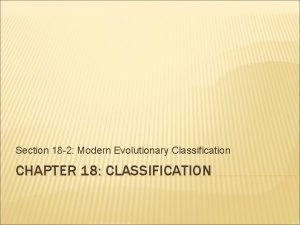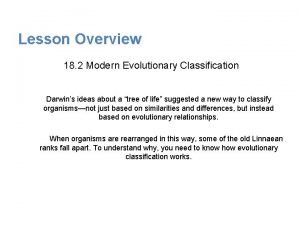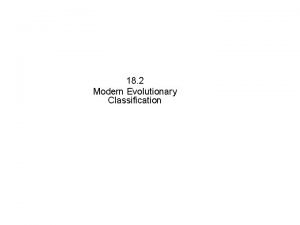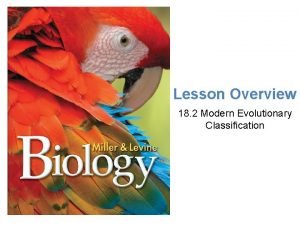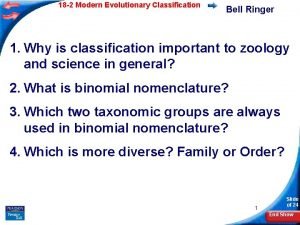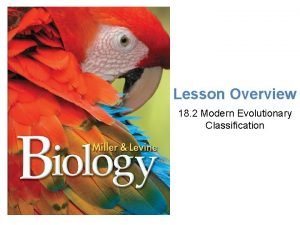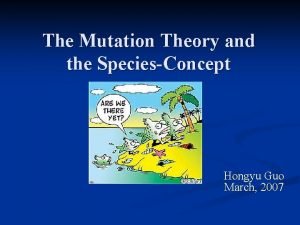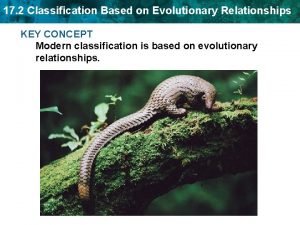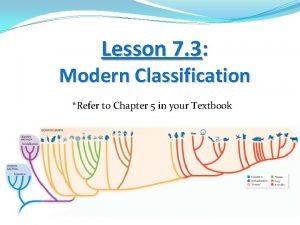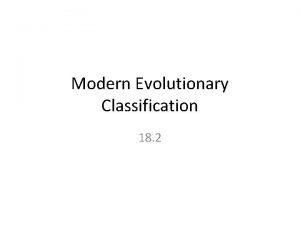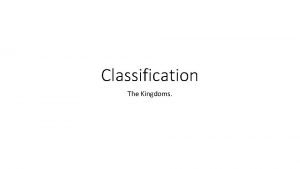18 2 Modern Evolutionary Classification Slide 1 of












- Slides: 12

18 -2 Modern Evolutionary Classification Slide 1 of 24 Copyright Pearson Prentice Hall End Show

18 -2 Modern Evolutionary Classification Phylogeny is the study of evolutionary relationships among organisms. Slide 2 of 24 Copyright Pearson Prentice Hall End Show

18 -2 Modern Evolutionary Classification Biologists currently group organisms into categories that represent lines of evolutionary descent, or phylogeny, not just physical similarities. The strategy of grouping organisms is based on evolutionary history and is called evolutionary classification. Slide 3 of 24 Copyright Pearson Prentice Hall End Show

18 -2 Modern Evolutionary Classification The higher the level of the taxon, the further back in time is the common ancestor of all the organisms in the taxon. Organisms that appear very similar may not share a recent common ancestor. Slide 4 of 24 Copyright Pearson Prentice Hall End Show

18 -2 Modern Evolutionary Classification Different Methods of Classification Appendages Crab Barnacle Mollusk Crustaceans Conical Shells Limpet Crab Barnacle Molted external skeleton Segmentation CLASSIFICATION BASED ON VISIBLE SIMILARITY Limpet Tiny freeswimming larva CLADOGRAM Slide 5 of 24 Copyright Pearson Prentice Hall End Show

18 -2 Modern Evolutionary Classification Using Cladograms Many biologists now use a method called cladistic analysis. Characteristics that appear in recent parts of a lineage but not in its older members are called derived characters. Slide 6 of 24 Copyright Pearson Prentice Hall End Show

18 -2 Modern Evolutionary Classification Using Cladograms Derived characters can be used to construct a cladogram, a diagram that shows the evolutionary relationships among a group of organisms. Slide 7 of 24 Copyright Pearson Prentice Hall End Show

18 -2 Modern Evolutionary Classification Using Cladograms A cladogram shows the evolutionary relationships between crabs, barnacles, and limpets. Crustaceans Mollusk Barnacle Crab Limpet Molted external skeleton Segmentation Tiny free-swimming larva Slide 8 of 24 Copyright Pearson Prentice Hall End Show

18 -2 Modern Evolutionary Classification Similarities in DNA and RNA The genes of many organisms show important similarities at the molecular level. Similarities in DNA can be used to help determine classification and evolutionary relationships. Slide 9 of 24 Copyright Pearson Prentice Hall End Show

18 -2 Modern Evolutionary Classification Similarities in DNA and RNA The genes of many organisms show important similarities at the molecular level. Similarities in DNA can be used to help determine classification and evolutionary relationships. Slide 10 of 24 Copyright Pearson Prentice Hall End Show

18 -2 Modern Evolutionary Classification DNA Evidence Similarities in DNA and RNA The more similar the DNA of two species, the more recently they shared a common ancestor, and the more closely they are related in evolutionary terms. Slide 11 of 24 Copyright Pearson Prentice Hall End Show

18 -2 Modern Evolutionary Classification A gene in an ancestral species Molecular Clocks A molecular clock uses DNA comparisons to estimate the length of time that two species have been evolving independently. Molecular Clocks 2 mutations new mutation Species A 2 mutations new mutation Species B Species C Slide 12 of 24 End Show
 Section 18-2 modern evolutionary
Section 18-2 modern evolutionary What is the goal of evolutionary classification
What is the goal of evolutionary classification Section 18-2 modern evolutionary classification
Section 18-2 modern evolutionary classification Section 18-2 modern evolutionary classification
Section 18-2 modern evolutionary classification 18-2 modern evolutionary classification
18-2 modern evolutionary classification Section 18-2 modern evolutionary classification
Section 18-2 modern evolutionary classification Modern evolutionary classification
Modern evolutionary classification Heel and toe polka meaning
Heel and toe polka meaning Modern evolutionary synthesis
Modern evolutionary synthesis Classification is based on evolutionary relationships
Classification is based on evolutionary relationships Classification based on evolutionary relationships
Classification based on evolutionary relationships Traditional classification vs modern classification
Traditional classification vs modern classification Slide method factoring
Slide method factoring
